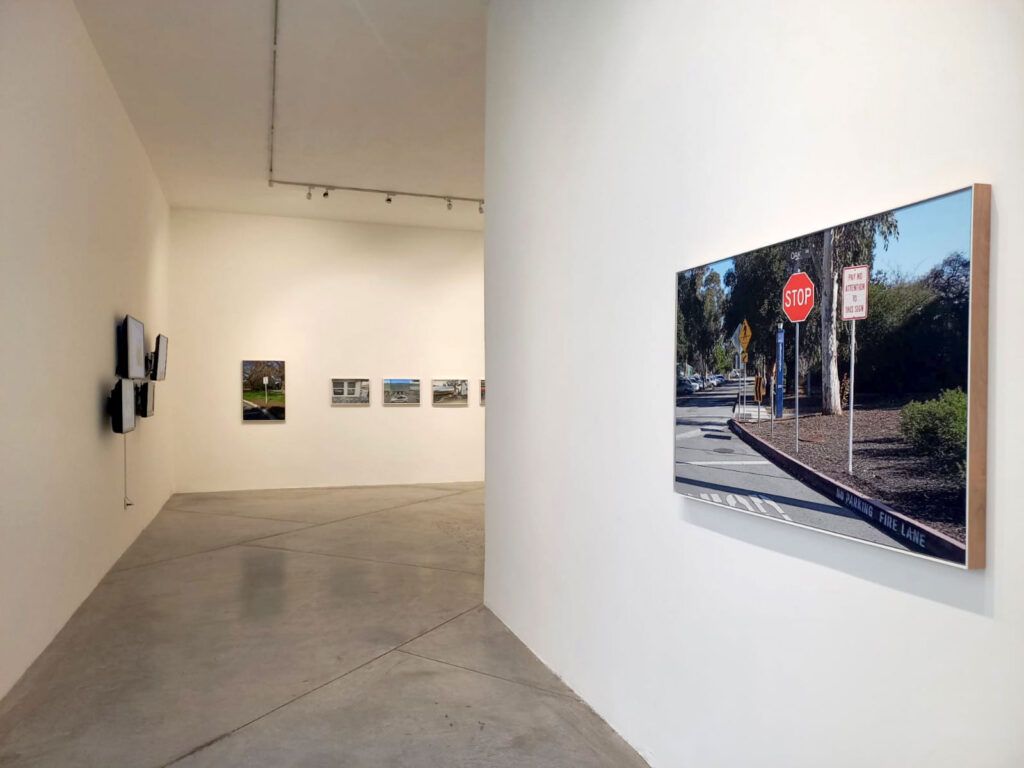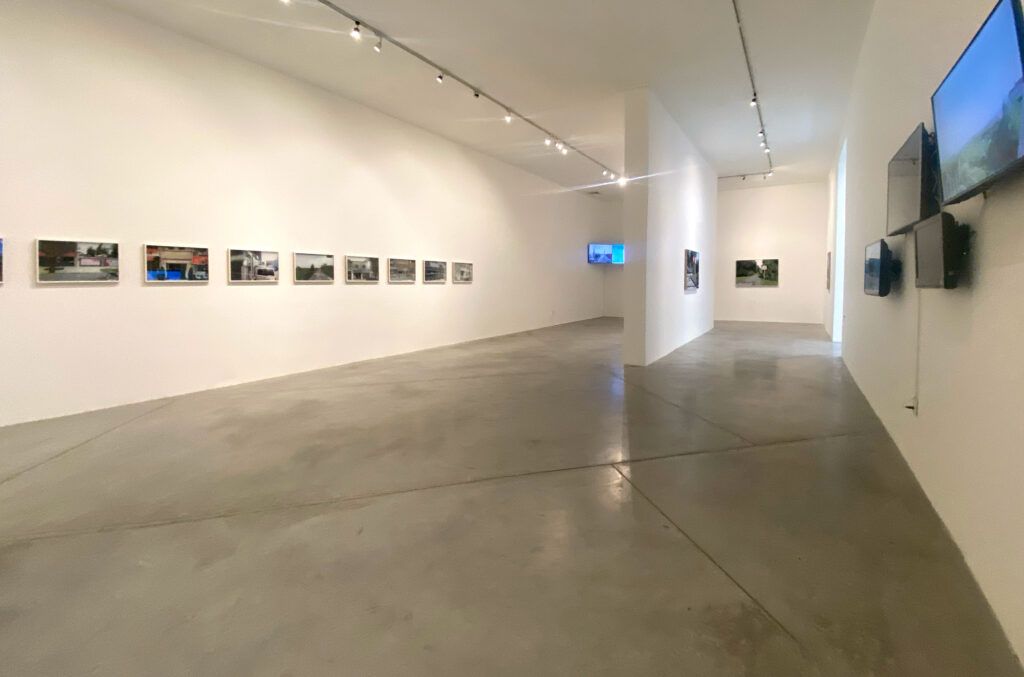Galería de Arte Mexicano presents The Surveilled Image. Miguel Monroy’s solo exhibition at the 2024 Mexico City Art Week.

Miguel Monroy and the Paradox of Indefinite Regression *
Itala Schmelz
The works presented here were made in 2020, during a stay by Miguel Monroy in San Francisco as he was getting his MFA at Stanford University. This area of California is the tip of the technological future known as Silicon Valley. If one wonders about the operation of conceptual art, it is worth following Monroy’s processes and strategies very closely. The first key to consider is that the context determines its production. Secondly, I propose that we think of his works as creations of singular events, as almost surgical irruptions in urban life, which cause a change in the logic of meaning, a discontinuity in normality.
Theorized by Gilles Deleuze in his book, Logic of Sense, the event is the present moment of realization, the material and spatial action, but it is also, “the pure expression that beckons us, is what must be understood, what It must be represented in what happens.” On the delicate edge between things and propositions, between Being and Language, meaning occurs, which, as the philosopher says, is a surface effect since it is not embodied in things or in propositions but comes off of them. The paradoxical event is a counter-effectuation insofar as it subverts the univocal order of meaning, creating relationships where the principle of non-contradiction is inoperative. In Monroy’s works, the meaning is not in what they materialize but in what they detonate, what happens in the ideality of thought.
In 2018, prior to his trip, the artist made Who Watches the Watchman? This work is presented on two screens: one documents the action or urban intervention of a drone filming, face to-face, a surveillance camera installed on Viaducto Avenue in Mexico City; the other screen shows the images produced by the drone when filming the surveillance camera.
Talking about the control of machines over individuals is not dystopian science fiction. Among the most efficient instruments are surveillance technologies using devices derived from the camera, which, interconnected by digital networks, are the eye of Big Brother watching you. The artist confronts a surveillance camera with a drone, two visual prostheses of increasingly omniscient and omnipresent artificial intelligence. The drone flies to the top of the pole, from where the camera extends its treacherous vision and challenges the camera in a duel of digital glances.
In this piece, we find, for the first time, what will be a constant throughout the exhibition, a regression or progression to infinity. In this case, the machine that monitors the machine that monitors, that monitors the machine that monitors the machine that watches. Soulless gazes and mechanical iris lenses register each other, generating a virtual echo that repeats itself between tireless mirrors.
In San Francisco, seeing signage in America produced an oppressive sensation of behavioral constriction in the artist. Coming from the rhizome city, it was confronted with the reticle city. The grid orders our steps and directs them according to a utilitarian operation: order and productivity. On the other hand, the rhizome is built experientially in our walk; the city is never the same. The behavior expected of the individual in the first world city is to follow the good sense of the signs and respect the signs: stop, do not pass, etc.; urban signage is a form of micro power. In his piece Traffic Signals, the artist makes false signage and installs it for a few days in certain parts of the city, generating an anomaly, an unexpected event that produces a feeling of strangeness. It was as if the city had been hacked, calling into question its rules, or at least the authority of its rules, by exposing them to absurdity.
Humor that calls for double meaning or the opposite meaning questions the seriousness of the single meaning. These discordant signs in the city alter the established order as if the city began to deviate. By placing his signs in public spaces, the artist opens a paradox of meaning, a micro-misalignment of the machinery of social control. Among the signs created by Monroy is the prohibition sign: a crossed-out circle is simultaneously prohibited by another smaller sign. This leads us, again, to the paradox of indefinite regression: forbidden to prohibit to prohibit…
The artist presents us with a polyptych titled Selfie, made up of photographs from the Google Street View archives, a program developed in Silicon Valley to virtually reproduce all the streets of the world. To achieve detailed photo-mapping, the company puts cars with its logo printed and a camera on the roof into circulation through urban arteries, which make photographic records as they move through the streets. The artist looks for photos in which the image of these cars was trapped on some surface of the city: the windows of a shop, the mirrors of a skyscraper, the metal face of a truck, or the rearview mirror of a car that was turning around. He calls these accidents involuntary selfies.
This polyptych makes us think of the technologically reproduced city as a world of glass, refracting surfaces where the bodily reference is lost in a virtuality that multiplies and leads it astray in increasingly abstract corridors. On the other side of the screen, the city scanned by Google is the incorporeal double of the original city, a virtual space in which the selfie-reflection of Google’s cars was trapped like a ghost in the material world.
At Stanford University, a think tank is dedicated to generating right-wing policies that the United States applies in the world for control and domination. In this center is a tower, and in this tower is a bell tower, which houses bells made in Belgium. These bells are set to ring with a type of organ that makes them swing at different rhythms. In Concert for the Hoover Tower, the artist approached the pianist with access to this instrument and asked her to play the notes of the Socialist International, the anthem of leftist fraternities worldwide. Ringing libertarian bells in the corridors and gardens of an institution of neoliberal intelligence is getting to the heart of power and detonating a critical device there. The documentation of this action is a clear case of conceptual art as a generator of singular events or counter-effects. The melodic sound Monroy disseminates from the tower is the last thing that should be heard there: something is wrong; it doesn’t make sense. It is not an activist irruption, not even symbolic; it is just an obstruction in the logic of meaning, the creation of a paradox.
The mathematical formula that a scientist with the same last name conceived to explain the golden ratio of the snail’s spiral growth is known as the Fibonacci series. In short, it involves the serialized reproduction and rearrangement of a particular space or shape at one-third its size and rotated 90 degrees. This serialization goes towards the infinitely large as well as towards the infinitely small; that is, it grows and decreases at the same time. While in San Francisco, Monroy deconstructed a wall in his studio (along with his desk) following this geometric rule. In Estudio Fibonacci, an increasingly smaller proportion of the wall (along with its desk) is reconstructed and reinstalled on the same wall in a golden progression. For this exhibition, the artist recreated the Fibonacci Studio at the GAM. This piece is sculptural, unlike the other works, which document ephemeral events in public spaces. This artwork reveals the invisible structure that supports all the others. In each of his actions, the artist causes an anomaly, diffractions or conceptual folds that divert the univocality of meaning towards an endless labyrinth: the paradox of indefinite progression or regression.
*Translation from Spanish by Karla Centeno
Galería de Arte Mexicano, Gob. Rafael Rebollar 63, Col San Miguel Chapultepec, CDMX
del 6 de febrero al 30 de marzo de 2024
www.galeriadeartemexicano.com







